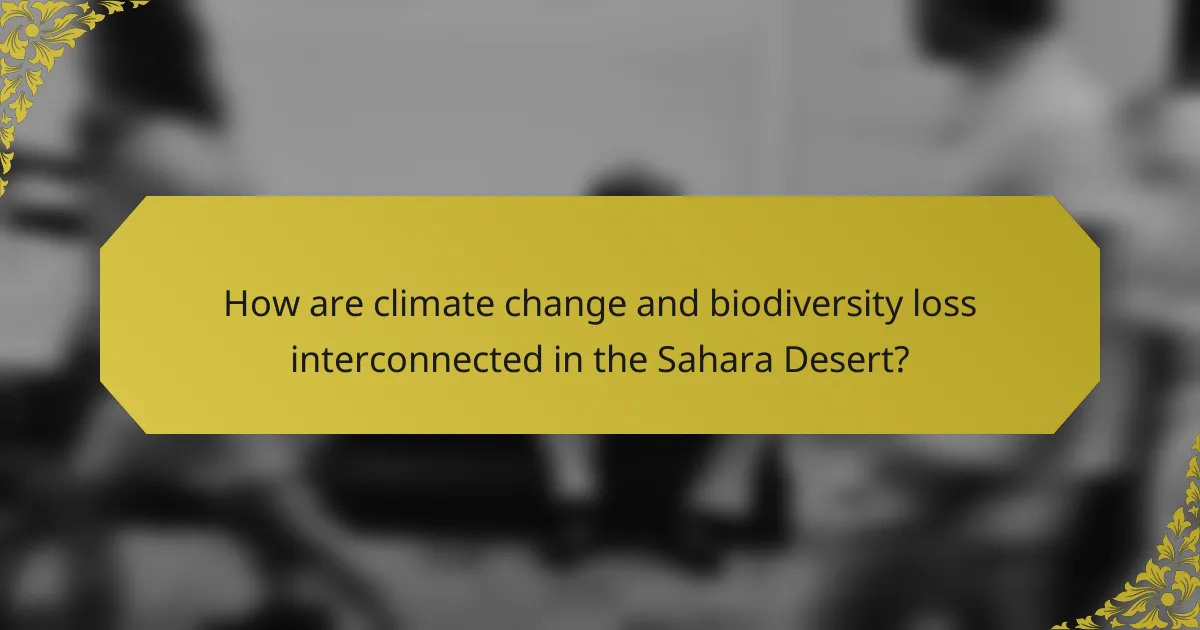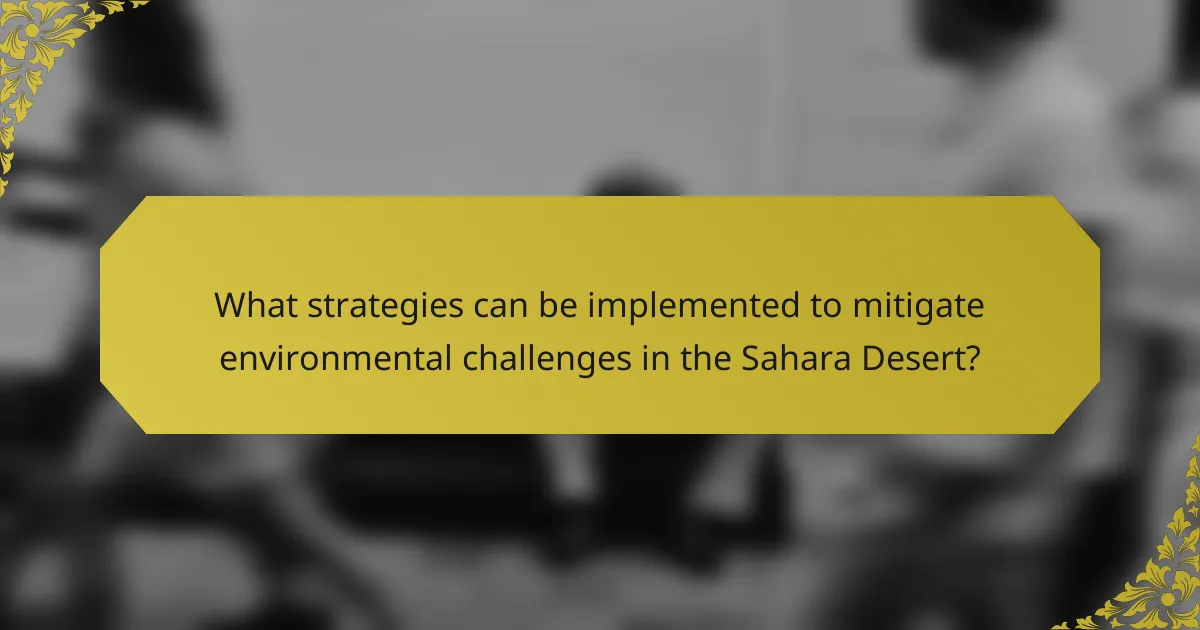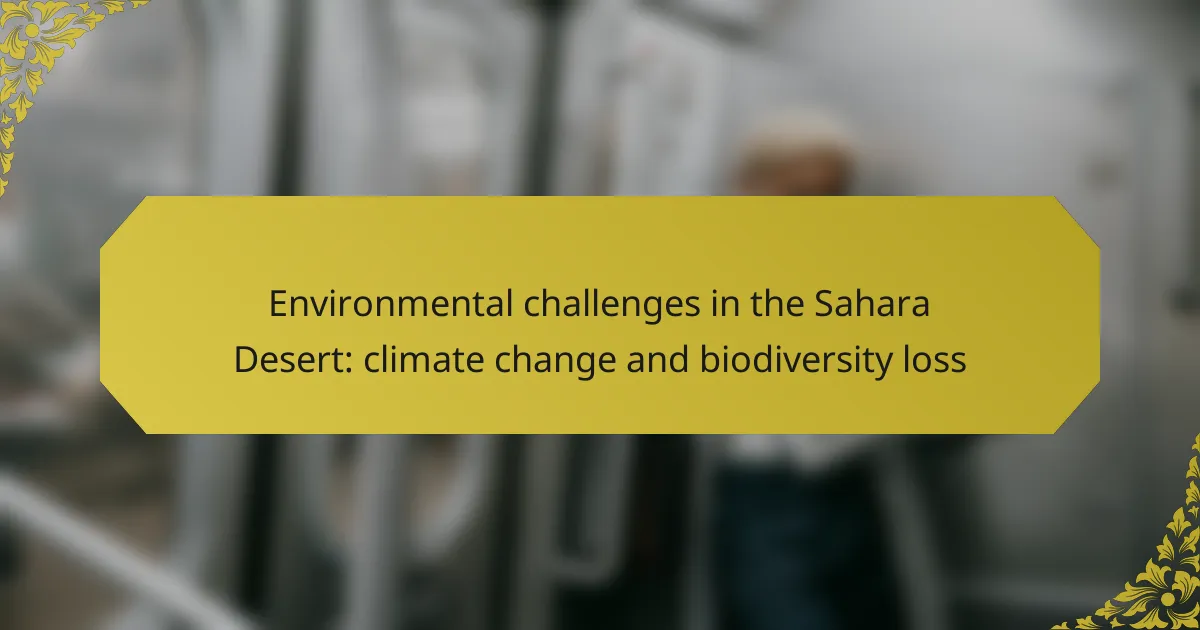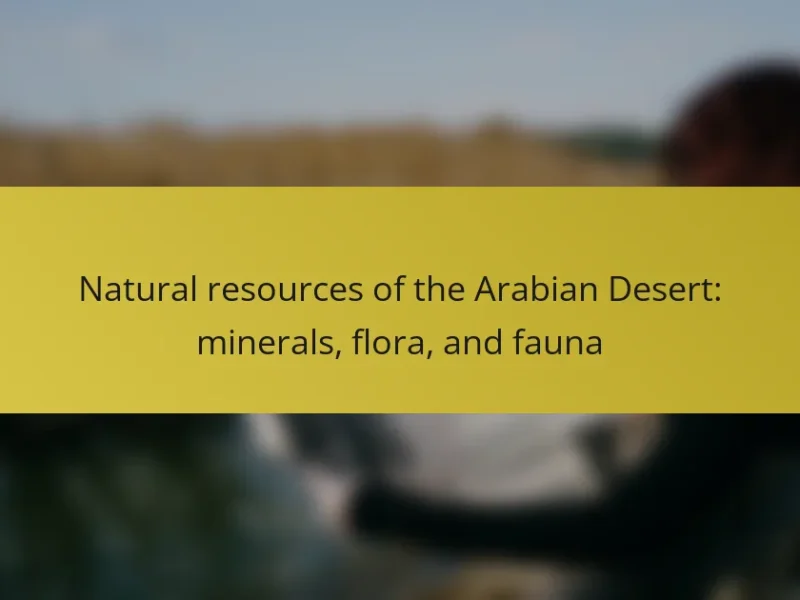
What are the primary environmental challenges in the Sahara Desert?
The primary environmental challenges in the Sahara Desert include desertification, water scarcity, and biodiversity loss. Desertification occurs due to climate change and unsustainable land use practices. It leads to the degradation of land and loss of arable soil. Water scarcity is exacerbated by low rainfall and high evaporation rates. The Sahara receives less than 3 inches of rain annually on average. Biodiversity loss affects both flora and fauna. Many species are threatened by habitat destruction and climate change. The unique ecosystems of the Sahara are vulnerable to these changes. These challenges impact local communities and their livelihoods.
How does climate change impact the Sahara Desert?
Climate change significantly impacts the Sahara Desert by altering its temperature and precipitation patterns. Increased temperatures lead to more extreme heat events, which can exacerbate desertification. The region is experiencing reduced rainfall, resulting in water scarcity. This scarcity affects both plant and animal life, threatening biodiversity. Changes in climate also influence the frequency of dust storms, which can affect air quality and human health. According to the Intergovernmental Panel on Climate Change (IPCC), the Sahara’s climate is projected to become even drier and hotter in the coming decades. These changes can disrupt local ecosystems and livelihoods dependent on agriculture and natural resources.
What specific climate change effects are observed in the Sahara?
Climate change effects observed in the Sahara include rising temperatures and increased desertification. Average temperatures in the Sahara have risen by approximately 1.5°C over the past century. This warming leads to more intense heatwaves, impacting both human and wildlife populations. Additionally, precipitation patterns are changing, with some areas experiencing reduced rainfall. This reduction exacerbates water scarcity in the region. The combination of higher temperatures and less rainfall accelerates desertification processes. Vegetation cover is declining, affecting local ecosystems and biodiversity. These changes threaten the livelihoods of communities dependent on agriculture and pastoralism.
How does temperature increase influence the desert ecosystem?
Temperature increase negatively impacts the desert ecosystem by altering species distribution and water availability. Higher temperatures lead to increased evaporation rates, reducing soil moisture. This affects plant growth and can result in decreased vegetation cover. Consequently, herbivores may struggle to find food, impacting their populations. Predators relying on these herbivores may also face food shortages. Additionally, higher temperatures can exacerbate drought conditions, further stressing the ecosystem. Studies indicate that desert temperatures have risen by approximately 1.5 degrees Celsius over the past century, significantly affecting local biodiversity. These changes threaten the delicate balance of the desert environment.
What role does biodiversity play in the Sahara Desert?
Biodiversity in the Sahara Desert plays a critical role in maintaining ecosystem stability. It supports various species that contribute to soil health and nutrient cycling. Diverse plant life helps to prevent soil erosion by stabilizing the ground. Animal species contribute to pollination and seed dispersal, which are vital for plant reproduction. Biodiversity also enhances resilience against climate change impacts. For instance, varied species can adapt to changing conditions, ensuring ecosystem survival. The Sahara is home to unique adaptations, such as drought-resistant plants and migratory animals. These adaptations illustrate the importance of biodiversity in extreme environments.
How is biodiversity defined in the context of the Sahara?
Biodiversity in the context of the Sahara refers to the variety of life forms, including plants, animals, and microorganisms, within the desert ecosystem. This diversity is crucial for maintaining ecological balance and resilience. The Sahara is home to unique species adapted to extreme conditions. For example, the desert fox and various cacti exhibit specialized adaptations for survival. Biodiversity also contributes to ecosystem services, such as soil fertility and water retention. Studies indicate that the Sahara’s biodiversity is threatened by climate change and human activities. Loss of habitats and species can disrupt these critical ecological functions. Therefore, preserving biodiversity in the Sahara is essential for environmental sustainability.
Why is biodiversity important for the Sahara’s environmental health?
Biodiversity is crucial for the Sahara’s environmental health because it enhances ecosystem resilience. Diverse species contribute to soil fertility, water retention, and nutrient cycling. These processes are essential for sustaining vegetation in arid conditions. Biodiversity also supports food webs, ensuring stability in the ecosystem. Studies show that diverse ecosystems are better at recovering from disturbances. For instance, varied plant life can prevent soil erosion and desertification. Healthy biodiversity can mitigate the impacts of climate change by sequestering carbon. Overall, biodiversity is vital for maintaining the Sahara’s ecological balance and health.

How are climate change and biodiversity loss interconnected in the Sahara Desert?
Climate change and biodiversity loss in the Sahara Desert are interconnected through habitat degradation and species extinction. Rising temperatures and altered precipitation patterns negatively impact the desert’s ecosystems. These changes reduce the availability of water sources, which are crucial for many species. Diminished plant life leads to a decline in herbivore populations. As herbivores decrease, predators also face food scarcity. This chain reaction disrupts the entire food web in the Sahara. Additionally, climate change increases the frequency of extreme weather events, further stressing fragile habitats. Research shows that biodiversity loss reduces ecosystem resilience, making it harder for the Sahara to adapt to climate change.
What are the direct effects of climate change on Sahara biodiversity?
Climate change directly impacts Sahara biodiversity by altering habitats and species distributions. Rising temperatures lead to increased aridity, affecting plant and animal survival. Reduced rainfall results in habitat loss for many species. This change threatens endemic species, which rely on specific conditions. For instance, the Barbary macaque faces habitat degradation due to changing climates. Additionally, invasive species may thrive as native species decline. These shifts disrupt ecological balance and food webs. Overall, climate change poses significant risks to the unique biodiversity of the Sahara.
How does altered rainfall affect plant and animal species?
Altered rainfall significantly impacts plant and animal species by changing their habitats and food availability. Variations in rainfall can lead to droughts or floods, which disrupt ecosystems. For example, reduced rainfall can cause desertification, affecting plant growth and reducing food sources for herbivores. This, in turn, impacts carnivores that rely on herbivores for sustenance. Increased rainfall can lead to flooding, which may destroy habitats and displace species. Research indicates that in the Sahara Desert, changes in precipitation patterns have led to shifts in species distribution and biodiversity loss. Studies show that certain plant species are declining due to insufficient water, while others may thrive, altering the balance of the ecosystem.
What are the consequences of habitat loss due to climate change?
Habitat loss due to climate change leads to significant biodiversity decline. Species lose their natural environments, resulting in reduced population sizes. This loss often leads to extinction, particularly for specialized species. Ecosystems become less resilient to environmental changes. Disruption of food chains occurs as predator-prey relationships are altered. Additionally, habitat fragmentation limits species’ ability to migrate and adapt. Climate change exacerbates these effects by altering temperature and precipitation patterns. According to the Intergovernmental Panel on Climate Change (IPCC), nearly one million species are at risk of extinction due to habitat loss and climate change.
How can human activities exacerbate these environmental challenges?
Human activities can exacerbate environmental challenges in the Sahara Desert through deforestation, overgrazing, and unsustainable agriculture. Deforestation reduces vegetation cover, leading to soil erosion and desertification. Overgrazing by livestock depletes plant life, which is crucial for maintaining soil health. Unsustainable agriculture practices increase water usage and contribute to soil degradation. These activities disrupt local ecosystems, further threatening biodiversity. Additionally, urbanization and industrial development increase pollution and carbon emissions, intensifying climate change effects. According to the World Bank, desertification affects 12 million hectares of land annually, worsening food insecurity and habitat loss in the region.
What are the key human activities contributing to environmental degradation in the Sahara?
Key human activities contributing to environmental degradation in the Sahara include deforestation, overgrazing, and unsustainable agricultural practices. Deforestation occurs as communities cut down trees for fuel and construction. This leads to soil erosion and loss of biodiversity. Overgrazing by livestock depletes vegetation cover, making the land more vulnerable to desertification. Unsustainable agricultural practices, such as monoculture and excessive irrigation, strain water resources and degrade soil quality. These activities collectively exacerbate the effects of climate change in the region.
How do agricultural practices impact biodiversity in the Sahara?
Agricultural practices significantly impact biodiversity in the Sahara. Intensive farming leads to habitat destruction. This results in the loss of native plant and animal species. The use of chemical fertilizers and pesticides further degrades soil health. Soil degradation reduces the variety of organisms that can thrive. Overgrazing by livestock contributes to desertification. Desertification diminishes the habitat available for wildlife. Additionally, monoculture farming reduces genetic diversity among crops. This can make food systems more vulnerable to pests and diseases. Overall, agricultural practices threaten the delicate ecosystems in the Sahara.

What strategies can be implemented to mitigate environmental challenges in the Sahara Desert?
Implementing sustainable land management practices can mitigate environmental challenges in the Sahara Desert. These practices include reforestation and afforestation efforts to restore vegetation cover. Planting native tree species enhances soil quality and reduces erosion. Additionally, promoting agroforestry can improve food security while preserving biodiversity. Utilizing water conservation techniques, such as rainwater harvesting, optimizes scarce water resources. Establishing protected areas helps conserve endangered species and their habitats. Furthermore, community engagement in conservation initiatives fosters local stewardship and sustainable practices. These strategies align with successful projects, such as the Great Green Wall initiative, which aims to combat desertification across Africa.
What conservation efforts are currently in place in the Sahara?
Current conservation efforts in the Sahara include the establishment of protected areas and wildlife reserves. These initiatives aim to preserve biodiversity and combat habitat loss. Notable projects include the Transboundary Biosphere Reserve in the Saharan region, which spans multiple countries. This reserve facilitates cross-border cooperation for conservation. Additionally, reforestation programs are implemented to restore degraded landscapes. These programs focus on planting native species to enhance ecosystem resilience. Community-based conservation efforts also engage local populations in sustainable practices. These efforts help balance human needs with environmental protection. Overall, these initiatives contribute to mitigating the impacts of climate change in the Sahara.
How effective are these conservation strategies in addressing climate change?
Conservation strategies are effective in addressing climate change by enhancing ecosystem resilience. These strategies include reforestation, sustainable land management, and wildlife protection. Reforestation can sequester carbon dioxide, reducing greenhouse gas levels. Sustainable land management practices improve soil health and water retention. Wildlife protection helps maintain biodiversity, which is crucial for ecosystem stability. A study by the Intergovernmental Panel on Climate Change (IPCC) highlights that natural climate solutions could provide over one-third of the cost-effective climate mitigation needed by 2030. Implementing these strategies can significantly mitigate climate impacts in vulnerable regions like the Sahara Desert.
What role do local communities play in conservation efforts?
Local communities play a crucial role in conservation efforts by actively participating in sustainable practices. They often possess traditional knowledge about local ecosystems and biodiversity. This knowledge can enhance conservation strategies and improve resource management. Community-led initiatives can lead to more effective protection of natural resources. For example, local involvement in reforestation projects has shown significant positive outcomes in various regions. Additionally, communities often serve as stewards of their environment, monitoring changes and advocating for conservation policies. Their engagement fosters a sense of ownership and responsibility towards natural habitats. Studies indicate that conservation efforts are more successful when local communities are involved in decision-making processes.
What best practices can be adopted to promote sustainability in the Sahara?
Implementing sustainable land management practices is essential for promoting sustainability in the Sahara. This includes reforestation efforts to combat desertification. Planting native trees can help restore soil health and improve biodiversity. Utilizing water conservation techniques, such as rainwater harvesting, is also crucial. These methods can enhance water availability for local communities. Additionally, promoting sustainable agriculture practices can reduce the environmental impact of farming. Techniques like crop rotation and organic farming can improve soil quality. Education and community involvement are vital in these initiatives. Empowering local populations can lead to more effective sustainability practices.
How can sustainable agriculture help reduce biodiversity loss?
Sustainable agriculture can help reduce biodiversity loss by promoting practices that protect ecosystems. These practices include crop rotation, agroforestry, and organic farming. Crop rotation enhances soil health and reduces the need for chemical inputs. Agroforestry integrates trees into agricultural systems, providing habitats for various species. Organic farming avoids synthetic pesticides and fertilizers, which can harm non-target organisms. Research shows that sustainable agriculture can increase species richness and abundance. A study by the Food and Agriculture Organization found that sustainable practices can enhance biodiversity in agricultural landscapes. By fostering diverse plant and animal life, sustainable agriculture contributes to ecosystem resilience.
What are some successful case studies of environmental restoration in the Sahara?
Successful case studies of environmental restoration in the Sahara include the Great Green Wall initiative and the reforestation efforts in Niger. The Great Green Wall aims to combat desertification by planting trees across the Sahel region. This project has restored over 15 million hectares of land. In Niger, local communities have successfully reforested 5 million hectares through agroforestry practices. These efforts have increased biodiversity and improved soil health. Additionally, these initiatives have enhanced food security for local populations. Both projects demonstrate effective collaboration between governments and communities. They provide a framework for further restoration efforts in the Sahara.
The primary entity of this article is the environmental challenges faced in the Sahara Desert, specifically focusing on climate change and biodiversity loss. The article outlines the main environmental issues, including desertification, water scarcity, and the decline of biodiversity, exacerbated by rising temperatures and altered precipitation patterns due to climate change. It discusses the interconnectedness of climate change and biodiversity loss, highlighting the impact of human activities on these challenges and the importance of sustainable practices. Additionally, the article reviews current conservation efforts and successful case studies aimed at restoring the Sahara’s ecosystems and promoting environmental sustainability.


